How To Copy An Animation Set From One Leg And Move It To Another Leg
This lesson provides an introduction to using freeform animation techniques with Biped.
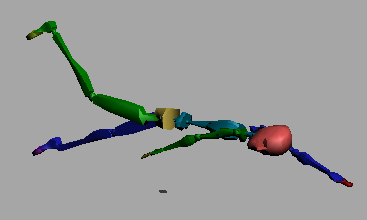
In this lesson, y'all will breathing a biped swimming in identify. You'll use freeform animation methods to produce the kicking legs and arm strokes.
In social club to create this motion, yous'll utilize a combination of rotations and moves. You'll too brand utilise of Re-create and Paste Posture Contrary to animate one arm and copy its tracks to the other.
Prepare the lesson:
- Reset 3ds Max.
- On the
 Create panel, click
Create panel, click  (Systems).
(Systems).
Create a biped and load a FIG file:
- Click to turn on
 (Biped), and and then create a biped in the Front viewport.
(Biped), and and then create a biped in the Front viewport. - Get to the
 Motion panel.
Motion panel. - Plow on
 (Figure Fashion), so click
(Figure Fashion), so click  (Load File).
(Load File). 3ds Max displays the Open dialog.
- Open the file tut_swimmer.fig. This file is in the folder \sceneassets\animations\.
The biped takes on new structural elements saved in the FIG file. This simplified figure has one large toe on each pes and i large finger on each hand, and its spine contains ii segments instead of 4.
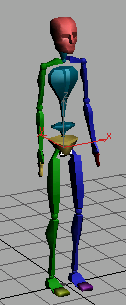
The biped with FIG file applied.
- Turn off
 (Figure Mode).
(Figure Mode). NoteYou cannot animate in Figure mode.
- Select all the biped objects, and then click
 (Zoom Extents All).
(Zoom Extents All). - Salve the scene as MySwimmer01.max.
Start a freeform animation:
You start a freeform animation by activating automatic primal recording and transforming any function of the biped.
- Right-click the Left viewport.
This activates the Left viewport without affecting the option in the scene.
- Printing Alt+W to maximize the viewport for a closer view of the biped.
The biped should be in wireframe. Change the shading display of the Left viewport if it is not wireframe.
- Turn on
 (Car Central).
(Car Central). The button turns scarlet, and the active viewport is outlined in red.
- On the
 Motion console
Motion console  Rail Selection rollout, click
Rail Selection rollout, click  (Torso Rotation).
(Torso Rotation). AnnotationActivating any of the Trunk ... buttons on the Track Selection rollout automatically selects the center of mass (COM) object.
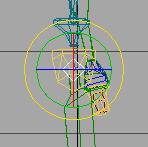
Rotation transform gizmo
The rotation transform gizmo lets you easily rotate an object virtually a called axis. Every bit y'all motion your cursor over the gizmo in the viewport, the axis circles turn yellow, indicating the axis around which the rotation will occur:
- The red circle, displayed every bit a vertical line in this viewport, affects the X axis.
- The dark-green circle affects the Y axis.
- The bluish circle, displayed as a horizontal line in this viewport, affects the Z centrality.
- The calorie-free gray circle, displayed effectually the green circumvolve, allows free rotation effectually all three axes.
- Move your cursor over the green circle.
The cursor turns yellow, meaning that any rotation is locked to that axis.
- Rotate the center of mass approximately ninety degrees nearly the Y axis. Lookout the coordinate readout about the gizmo to see how far y'all're rotating the biped. Rotate until the biped is lying prone.
TipIf y'all like, yous can printing A to turn on Angle Snap, which lets you easily rotate to 90 degrees.

An animation key appears at the far left of the track bar, at frame 0.
You can select all 3 COM tracks under Track Selection to create keyframes simultaneously. Try this:
- On the Rail Selection Rollout, click
 (Lock COM Keying), and then click
(Lock COM Keying), and then click  (Body Rotation).
(Body Rotation). - On the Track Selection rollout click to turn on both
 (Body Horizontal) and
(Body Horizontal) and  (Torso Vertical).
(Torso Vertical). All the multiple tracks for the COM are at present active.

- Expand the Key Info rollout and click
 (Set Key).
(Set Key). This sets keys for all the COM tracks at frame 0. The trackbar key shows a multi-color display, indicating that both position and rotation keys have been created.
- Click Lock COM Keying again to unlock the COM tracks.
TipIt'south a good idea to set a key at the start of your blitheness for the three COM tracks.
Pose one leg:
Now that the biped is decumbent, you're ready to breathing the swimming motion. Commencement, yous'll position the legs. You'll piece of work on the right leg beginning, setting up its position at frame 0.
- Printing Alt+W so yous tin can run into all four viewports over again.
- Select Bip01 R Thigh by clicking the lines of the thigh in the Left viewport.
TipAs you hold your cursor over an object in the viewport, the object'south proper name is displayed in a tooltip. You can also select an object past pressing H to cull objects from the selection list.
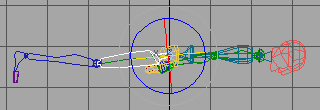
The correct thigh is selected.
- Rotate Bip01 R Thigh approximately −thirty degrees near the Z-axis.
The right leg is rotated, only the correct foot is pointing straight down.
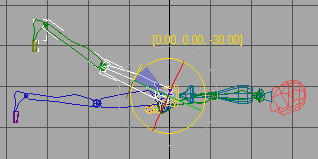
- Printing Folio Down twice to select the correct foot.
TipThe Page Up and Page Downwardly keys let yous quickly navigate through the objects that brand up a biped.
- Rotate Bip01 R Foot almost –50 degrees around the Z-axis.
The foot looks more natural in this position.
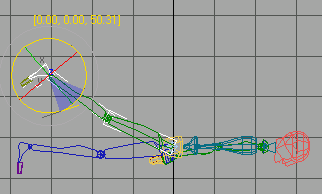
And so far yous've used merely forward kinematics to animate the biped. Next you'll use inverse kinematics past moving the foot to move the unabridged leg.
- Right-click the same foot and choose Move from the quad carte du jour.
TipYou can choose the transform tools either from the main toolbar or by right-clicking to open the quad menu.
The Transform gizmo switches to an centrality tripod showing 2 of three arrows in this viewport. They are displayed at right angles with the Z centrality pointing up and the Y axis pointing left.

Ready to move the pes.
- In the Left viewport, move the cursor over the Y axis of the gizmo until it turns yellow, so move the foot a little to the right.
The knee bends to accommodate the new position of the foot.
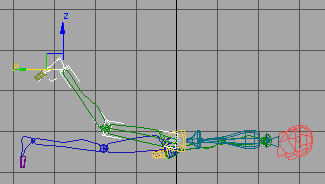
The knee bends.
In this move, you've merely used inverse kinematics. The human foot, calf, and thigh are linked together in a hierarchical concatenation. Past moving the terminate of the chain, the foot, you rotated the lower and upper leg objects.
-
 Save the scene as MySwimmer02.max.
Save the scene as MySwimmer02.max.
Animate the leg:
Everything you've done so far has been at frame 0. At present you'll motion forward in fourth dimension and animate the pose at frame ten.
- Drag the time slider to frame 10.
-
 Move the human foot down on the Z centrality until the human knee straightens out.
Move the human foot down on the Z centrality until the human knee straightens out. 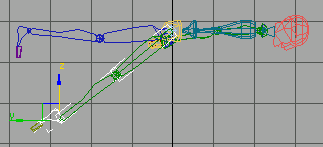
- Printing Page Up twice to select Bip01 R Thigh.
- Right-click and cull Rotate from the quad menu, so rotate the Bip01 R Thigh approximately −10 degrees about the Z axis.
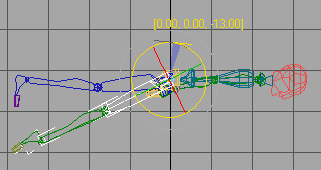
Rotating the thigh.
- Scrub the time slider back and forth between frame 0 and frame ten.
The leg moves up and downwards.
Use copy and paste:
Now you'll employ some specialized Biped tools to pose and breathing the opposite leg.
- Return the time slider to frame x.
- Double-click Bip01 R Thigh.
The entire leg is selected from the thigh down to the toes.
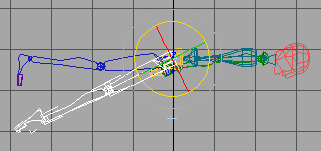
- On the
 Motion panel, expand the Copy/Paste rollout.
Motion panel, expand the Copy/Paste rollout. The Copy/Paste functionality includes the creation of collections. Yous must create a drove before y'all can start creating postures.
- On the Re-create/Paste rollout, click
 (Create Collection). This creates a collection named Col01. Rename it to Swim – Clamber.
(Create Collection). This creates a collection named Col01. Rename it to Swim – Clamber. - Make sure that the Posture button is active.

- Also make sure that Capture Snapshot From Viewport is chosen. This button is just above the Paste Options group.

Choosing Capture Snapshot From Viewport forces the thumbnail of the pose to be taken from the active viewport. This particular posture, for example, is better seen from the Left viewport rather than the Front.
- Click
 (Copy Posture).
(Copy Posture). 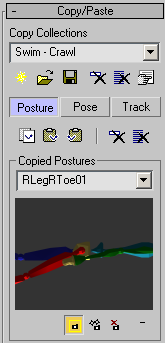
The posture of the right leg is copied into a buffer. Alter the name of the Copied Posture to RLeg – downkick.
- Drag the time slider back to frame 0. Click
 (Paste Posture Opposite).
(Paste Posture Opposite). The left leg rotates down. The correct leg hierarchy is notwithstanding selected.
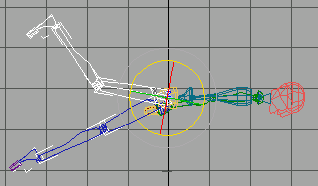
- At frame 0, click
 (Copy Posture) again.
(Copy Posture) again. - Drag the time slider to frame 10.
- Click
 (Paste Posture Opposite) again.
(Paste Posture Opposite) again. Now the left leg is raised, and the right leg is down.
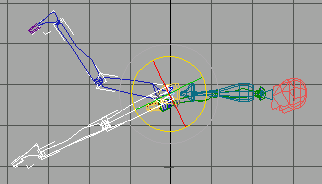
- Scrub the time slider back and forth between frames 0 and x and watch the legs kick.
Now you'll repeat this process to make the legs kick several times.
- Relieve the scene as MySwimmer03.max.
Apply Paste Posture to create multiple kicks:
You tin can use the Copy Posture tools to apace duplicate all the leg keys from one frame to another to create repeated boot motions.
- Make sure that
 (Auto Key) is nonetheless on and drag the time slider to frame 0.
(Auto Key) is nonetheless on and drag the time slider to frame 0. - On the Rails Option rollout, click
 (Symmetrical).
(Symmetrical). Now both legs are selected.
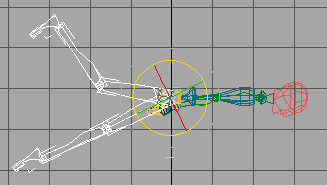
- At frame 0, click
 (Copy Posture). Name the copied posture R up L downwardly.
(Copy Posture). Name the copied posture R up L downwardly. 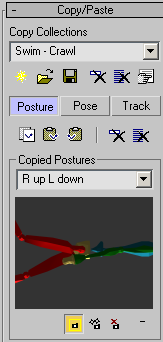
Both legs are added to the collection.
- Drag the time slider to frame 20.
TipYou can blazon in the frame number in the Current Frame fourth dimension control.

- At frame 20, click
 (Paste Posture).
(Paste Posture). - Go to frame 30 and click
 (Paste Posture Opposite).
(Paste Posture Opposite). From this point forwards, you lot tin can click either Paste or Paste Reverse as you create a boot wheel. For a smooth boot cycle, simply alternating the posture every 10 frames up to frame 80. The runway bar displays a total of nine keys for the blitheness of the legs.
- In the Copy Collections group click the Salve Collection button to save your collection. Proper name the collection Swim – Crawl. The CPY extension is automatically added to the name.
- Save the scene as MySwimmer04.max.
Animating a kicking leg was adequately like shooting fish in a barrel, requiring just two poses: one with the leg up, and one with the leg down. Animating the arms is more circuitous. To animate the stroke of an arm, you'll demand five poses:
- The arm outstretched
- The arm down
- The arm back
- The arm drawn up out of the water about the ear
- The arm entering the water
When 1 arm is animated correctly, yous'll utilize Re-create Track and Paste Opposite Track to animate the 2nd arm. You'll suit the timing of the 2nd arm by sliding the keys in the track bar.
Animate one arm:
- Make certain that
 (Auto Key) is notwithstanding on, and drag the time slider to frame 0.
(Auto Key) is notwithstanding on, and drag the time slider to frame 0. - Press H. In the Select From Scene dialog, select Bip01 Fifty UpperArm.
- In the Left viewport,
 rotate Bip01 L UpperArm approximately −160 degrees about the Z centrality, until it is extended in front of the biped.
rotate Bip01 L UpperArm approximately −160 degrees about the Z centrality, until it is extended in front of the biped. 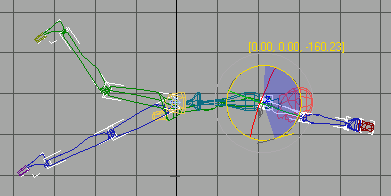
- Right-click the Summit viewport and press Page Up to select Bip01 L Clavicle and rotate it −20 degrees virtually the Y axis.
This should preclude the arm from passing through the caput.
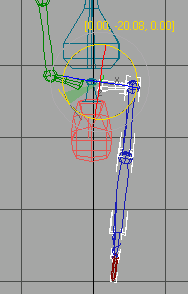
- In the same viewport, press Folio Down 3 times to select Bip01 L Hand. Rotate it approximately −90 degrees nigh the X axis so the palm is facing down.
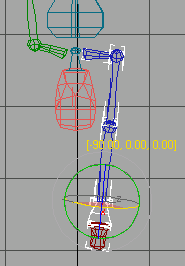
This completes the first arm pose, so it's a good fourth dimension to save your data.
- Double-click Bip01 LClavicle to select the entire left arm hierarchy.
- Activate the Perspective viewport so that the snapshot will be easier to identify, and then click Copy Posture. Name the pose LArm extended.
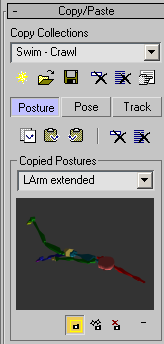
Thumbnail snapshot from perspective viewport.
- Drag the fourth dimension slider to frame 10.
- On the main toolbar, click
 (Select And Move), and then change the Reference Coordinate System to World, if it isn't already set to Globe.
(Select And Move), and then change the Reference Coordinate System to World, if it isn't already set to Globe. 
This volition facilitate working with the Transform gizmo in unlike viewports.
- Right-click in the Left viewport. Move Bip01 L Mitt downwardly on the Y and Z axes until it points direct downwardly. This completes the second arm pose.
TipIf you catch the Motility gizmo by the corner where the two axes encounter, y'all can motion selected objects on both axes at once; that is, on the YZ plane.

- Double-click Bip01 LUpperArm to select the arm hierarchy, then click
 (Re-create Posture). Proper noun the pose LArm downward.
(Re-create Posture). Proper noun the pose LArm downward. - Elevate the time slider to frame twenty.
-
 Motility Bip01 L Mitt forth the Y axis toward the legs.
Motility Bip01 L Mitt forth the Y axis toward the legs. 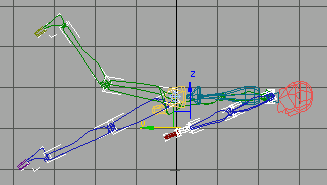
- Actuate the Front viewport and press Page Upward three times to select Bip01 L Clavicle.
 Rotate this role well-nigh 24 degrees effectually the Z axis.
Rotate this role well-nigh 24 degrees effectually the Z axis. This completes the third arm pose. Save it past double-clicking Bip01 L UpperArm in the Top viewport to select the hierarchy, so click
 Copy Posture. Name the pose LArm dorsum. If you actuate the Perspective viewport earlier you copy the posture, you can adjust the viewport so the pose is clearly visible in the thumbnail.
Copy Posture. Name the pose LArm dorsum. If you actuate the Perspective viewport earlier you copy the posture, you can adjust the viewport so the pose is clearly visible in the thumbnail. 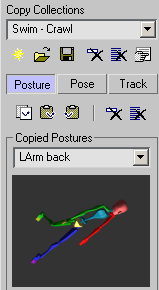
- Drag the time slider to frame xxx.
- Activate the Top viewport.
-
 Motility Bip01 Fifty Hand in the XY plane until the hand is level with the shoulder.
Motility Bip01 Fifty Hand in the XY plane until the hand is level with the shoulder. 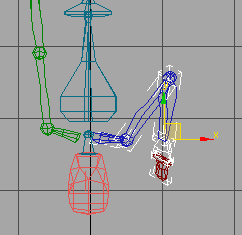
- In the Left viewport,
 motility Bip01 50 Hand on the Z axis so it is well-nigh the ear.
motility Bip01 50 Hand on the Z axis so it is well-nigh the ear. 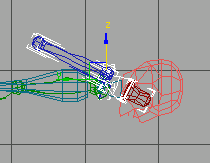
- Finally,
 rotate Bip01 L Hand about the 10 axis and then the palm is apartment.
rotate Bip01 L Hand about the 10 axis and then the palm is apartment. This completes the fourth arm pose. Save it to the collection by double-clicking the upper arm to select the unabridged hierarchy, so click
 (Copy Posture). Proper name the pose LArm up.
(Copy Posture). Proper name the pose LArm up. 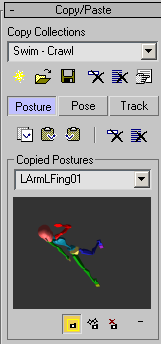
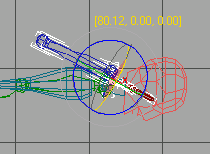
- To create the fifth pose, get to frame 37.
- In the Left Viewport,
 move the Bip01L Manus object on the Y axis so it is in front of the caput, and is level with the shoulders. Double-click the Bip01 Fifty Upperarm to select the unabridged arm hierarchy, actuate the Perspective viewport, so click
move the Bip01L Manus object on the Y axis so it is in front of the caput, and is level with the shoulders. Double-click the Bip01 Fifty Upperarm to select the unabridged arm hierarchy, actuate the Perspective viewport, so click  (Copy Posture). Name the pose LArm stroke.
(Copy Posture). Name the pose LArm stroke. NoteThe fifth pose is used to ensure that the rotation of the arm is correct going from the out-of-water pose to the extended pose.
- Salve the scene as MySwimmer05.max.
Applying a twist pose:
You can use twist poses to right upper arm rotations. Twist poses are primarily used to correct arm twisting, just in this case we'll utilize it to simply position the arm efficiently.
- Plough off
 (Auto Primal) if it is on.
(Auto Primal) if it is on. - Select Bip01 L Upperarm.
- Drag the fourth dimension slider to frame 33.
- Expand the Twist Poses rollout.
- In the Twist Poses drib-downwards listing, cull each pose and notice the change to the arm in the viewport.
Consider these default poses as additional copied postures that you lot tin can use to "straighten out" bug past defaulting to fixed rotations.

Twist Poses
- When pose 5 is selected, the arm will be rotated and positioned correctly. Expand the Key Info rollout and click
 (Set Key) to keyframe the twist pose.
(Set Key) to keyframe the twist pose. 
Default Twist pose five.
TipTwist poses are designed to help yous fix twisting that occurs in the mesh attached to the biped. If you go to Figure Manner, you can enable Twist Links by turning on the Twists check box, then set the number of twist links you lot would like for the upper arm, forearm, thigh, dogie, or "horse-link" (the extra link in the Leg if Leg Links are set to 4). Unfreeze and unhide all and you will exist able to see the twist basic that have been added using this method. Once the Twist Links functionality is enabled you can play with the Twist and Bias settings.
Copy the Arm pose:
To complete the arm cycle, in the next few steps you'll copy the arm pose to frame 40.
- Turn on
 (Car Central).
(Car Central). - In the Height viewport, double-click Bip01 L Clavicle to select the entire left arm.
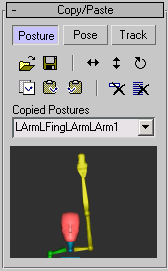
- At frame 33, click
 (Copy Posture).
(Copy Posture). - Advance the time slider to frame forty, and click
 (Paste Posture).
(Paste Posture). If you run into whatever unusual rotations or out-of-place movements, you tin set up additional keys to refine the animation.
- Drag the time slider and scout the animation.
Repeat the animation:
If the animation is going to exist 80 frames in length, you'll need to repeat the arm movement.
- Double-click Bip01 L Clavicle, to select the entire left arm, if it'southward not already selected.
- In the track bar, elevate a selection window around the keys for frames ten through 40.
- Agree down the Shift key and copy these keys past dragging them to the correct. When the first key is over frame fifty, release the mouse button.
-
 Play the blitheness. The biped should perform two complete strokes with its left arm.
Play the blitheness. The biped should perform two complete strokes with its left arm. - Relieve your scene as MySwimmer07.max.
Add together rotation to the spine:
Next you'll add some rotations for the spine to brand the animation more disarming. This spine of this biped effigy (tut_swimmer.fig) has but 2 segments. You'll rotate the large department representing the upper body.
- Make sure that
 (Auto Fundamental) is even so on.
(Auto Fundamental) is even so on. -
 Select Bip01 Spine1.
Select Bip01 Spine1. NoteThe get-go spine object is Bip01 Spine . The large second spine object is Bip01 Spine1 .
- Right-click the Forepart viewport.
- Drag the time slider to frame 0, and on the Key Info rollout, click
 (Fix Key).
(Fix Key). This sets a showtime primal for the rotation.
- Drag the fourth dimension slider to frame 10 and
 rotate Bip01 Spine1 approximately −15 degrees about the X axis.
rotate Bip01 Spine1 approximately −15 degrees about the X axis. This makes the trunk announced to follow the movement of the arm.
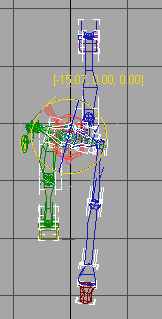
Spine rotation
- On the track bar, click the key at frame 0 to select it, so concord downwardly the Shift central and drag a re-create to frame 30. Watch the status surface area to know when you are at frame 30.

The spine now rotates once in the 40-frame wheel.
- Select Bip01 Pelvis.
- Drag the time slider to frame 0, and on the Key Info rollout, click
 (Set Key).
(Set Key). This sets a start central for the rotation.
- Drag the time slider to frame ten, and
 rotate the pelvis a few degrees in X so it follows the motility of the left leg.
rotate the pelvis a few degrees in X so it follows the motility of the left leg. 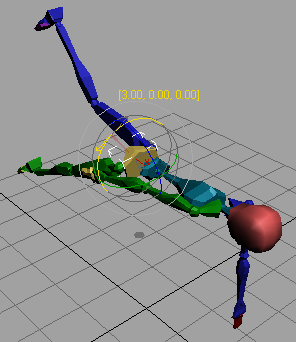
Rotate the pelvis.
- Copy these two keys to frames 20 and xxx.
TipFor the pelvis, you lot tin can besides add a few degrees of rotation around the Y centrality, if you like.
Next, y'all'll copy the pelvis and spine rotation keys to repeat the motion.
- Make certain that the pelvis is even so selected, then hold downward the Ctrl key and click the Bip01 Spine01 object (the large torso spine object).
- In the track bar, drag a selection rectangle around the four visible keys.
- Hold down the Shift key and drag the keys so the leftmost fundamental is copied to frame twoscore. Scrub the fourth dimension slider back and forth to encounter the blitheness.
- Copy the key from frame 0 to frame 80 to complete the fix of keys.

The final set up of Bip01 Spine1 keys.
Animate the head:
The biped can breathe every bit it swims, if yous animate the head rotation appropriately.
- Brand sure that
 (Auto Key) is still on.
(Auto Key) is still on. - In the Left viewport,
 select the biped'south head, Bip01 Caput.
select the biped'south head, Bip01 Caput. - Drag the time slider to frame 0, and
 rotate the caput virtually 70 degrees around the X axis, so the biped's left ear is pointing down.
rotate the caput virtually 70 degrees around the X axis, so the biped's left ear is pointing down. 
Rotate the head for breathing motion.
TipSpotter the Perspective viewport while rotating in the Left viewport.
- At frame xx,
 rotate the head back down.
rotate the head back down. 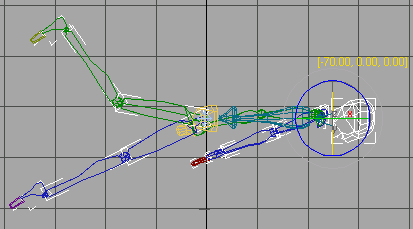
- Hold down the Shift key and elevate to copy the fundamental at frame 0 to frame twoscore. Watch the condition area to know when you are at frame twoscore.
- Scrub the fourth dimension slider to observe the head rotation.
Actually, information technology would look better if the head were turned upwardly at frame 30.
- Slide the key you lot made at frame 20 along the runway bar to frame thirty. Do not hold down the Shift central for this stride.
The biped lifts and lowers its head one time in the 40-frame cycle.
TipYou can drag the time slider to frame 30, then slide the central on top of information technology.
- To explore another way to copy keys, right-click the time slider.
The Create Key dialog is displayed. This lets you create keys by choosing a source and a destination.
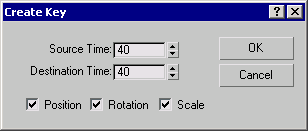
TipYou don't have to turn on Machine Key to set keys this way.
- Set Source Time to 30 and Destination Time to 70, and and then click OK.
- Right-click the time slider again.
- Fix Source Time to 0 and Destination Fourth dimension to 80, and then click OK.
This completes the head motility, merely the right arm motions still need piece of work. That comes next.
Animate the other arm with Copy Tracks:
Re-create Tracks lets you copy and paste the animation tracks of selected objects to other objects, or to reverse body parts.
- Make sure that
 (Motorcar Key) is even so on.
(Motorcar Key) is even so on. - In the Height viewport, double-click Bip01 L Clavicle to select the unabridged left arm.
- Activate the Perspective Viewport.
- On the Copy/Paste rollout, turn on
 (Runway).
(Runway). - Click
 (Re-create Track).
(Re-create Track). The track is copied to the buffer. Proper name the track LArm – Crawl.
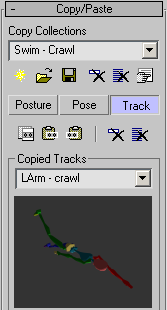
- Click
 (Paste Track Opposite).
(Paste Track Opposite). 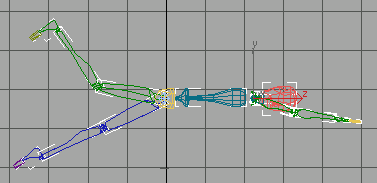
-
 Play the animation.
Play the animation. The biped is pond the butterfly stroke. The two arms motility together.
Next you'll alter the timing and so the arms alternating.
- In the Top viewport, double-click the Bip01 R Clavicle.
The unabridged right arm is selected in the viewport.
- Elevate a box effectually all the keys in the rails bar to select them. Slide all the keys 20 frames to the right.

The biped pond a freestyle stroke.
-
 Play the animation.
Play the animation. Now the first and end are not quite correct. The easiest way to correct this is to copy and paste poses.
Gear up the beginning and end:
- Make certain that
 (Auto Key) is still on.
(Auto Key) is still on. - In the Top viewport,
 double-click the Bip01 R Clavicle to select the entire right arm, if it's non already selected.
double-click the Bip01 R Clavicle to select the entire right arm, if it's non already selected. - On the Copy/Paste rollout, click
 (Posture).
(Posture). - Drag the time slider to frame fifty, and click
 (Copy Posture).
(Copy Posture). - Drag the time slider dorsum to frame x, and click
 (Paste Posture).
(Paste Posture). - At frame xl, click
 (Copy Posture), and so at frame 0, click
(Copy Posture), and so at frame 0, click  (Paste Posture).
(Paste Posture). Now the artillery alternate.

To correct the other end of the blitheness, you tin can crop the animation to 80 frames.
- In the time controls, click
 (Time Configuration).
(Time Configuration). 3ds Max opens the Fourth dimension Configuration dialog.

- In the Animation group, change the Cease Time to 80. Click OK.
WarningDo non click Re-scale Time.
-
 Play the animation.
Play the animation.
Relieve your work:
- On the Biped rollout, click
 (Relieve File) and save the movement equally MySwimmer.bip.
(Relieve File) and save the movement equally MySwimmer.bip. - Also
 save your final scene as MySwimmer08.max.
save your final scene as MySwimmer08.max.
Perfecting the animation:
- If you like, you can improve the blitheness by adding some rotation keys to the pelvis and spine and by adding secondary motion to the feet and hands. Stagger the rotations of the extremities a few frames post-obit the movement of the hands and anxiety.
To see a finished version of the swimmer, y'all tin can get to \scenes\character_animation\freeform_animation and open swim.max.
Source: https://download.autodesk.com/us/3dsmax/2011/help/files/WS1a9193826455f5ff-e569a012180ce58911127.htm
Posted by: rainesoves1951.blogspot.com

0 Response to "How To Copy An Animation Set From One Leg And Move It To Another Leg"
Post a Comment